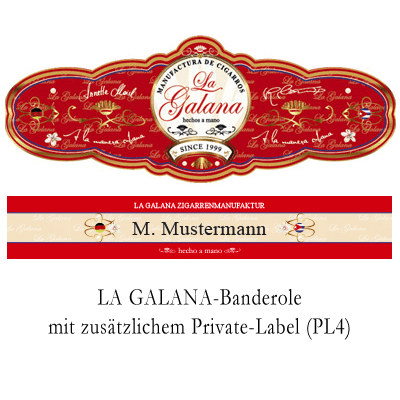Delicate tobacco – cigars for women
Podcast WDR 3 Kultur am Mittag from July 18th, 2019 6:02 min.
Delicate Tobak – Cigars for Women was the title of a report on WDR 3 last week about the LA GALANA cigar manufacturer. Who still remembers the time when cigars were made in Germany? Cigar rolling is not an exclusively Cuban craft. The art of rolling was practiced in Germany from the 17th century until well into the 20th century and is continued today by us in the La Galana Salon in a small and fine way. WDR was particularly interested in the emancipatory aspect of cigar rolling. This was a job that women were allowed to do hundreds of years ago, a small piece of emancipation. And you can find out what Carmen, the famous character from Bizet's opera, has to do with it in this report...
transcription
Moderator:
The cigar is a symbol of enjoyment. Usually smoked late at night, in a cigar lounge with something hard in the glass, mostly by men. I assumed that the fine cheroots were only rolled in their country of origin, for example in Cuba, but no, cigars are also made by hand in the middle of Cologne. At the La Galana tobacco shop. , Diana Zulfoghari was instructed in the art of rolling cigars and immediately felt like she was in the Caribbean.
Diana Zulfoghari:
It's only a few steps from Cologne to Cuba. Heavy red velvet curtains, a piano that has survived two world wars and a lounge in front of a photo wall with the inevitable vintage car. On the table is a gigantic marble ashtray. Old tube radios and suitcases are stacked up to the ceiling. A cigar salon, a factory that floats completely outside of time. As if smoking hadn't been banned everywhere for a long time, as if there weren't horror images of illness and infirmity on cigarette packs. Here, tobacco consumption is celebrated as a way of life. Annette Meisl: “Autumn leaves, berries, there are a lot of wonderful terms. Personally, I don’t have a very detailed sense of taste and we only have taste buds in our mouths. And therefore it makes no sense at all to inhale.” Annette Meisl is a kind of high priestess of tobacco. Men and women hang on each other's lips, sink into deep leather cushions and take a sip of rum to accompany their hand-rolled cigar. "Well, first of all, I'm an artist, I write books, I sing and create worlds, that's my hobby and La Galana is a work of art for me too, I created La Galana as a world."
La Galana - that's the name of the tobacco shop, the salon, that's what it says on the pale red bands of the cigars, of course La Galana also has a meaning. “That means gentlewoman, the meaning in Spanish ranges from noblewoman to bon vivant and for me that is exactly what I see as potential in a woman. We have everything within us.”
Well, Bizet's Carmen could also afford her amorous escapades because she earned her own money rolling cigars. An emancipatory step indeed, one of the few professions in which women received the same wages as men, even 200 years ago. Not everyone went to the factory like the opera Carmen in Seville. Seville, Havana and Bünde, Germany also has a long tradition of rolling cigars. The only job that many women were allowed to pursue, explains Annette Meisl. “I met old women at events who said – I remember that, I did that too at the kitchen table back then – that was common, working from home.
Not dreary piecework, no, it's a real art. Annette Meisl is now demonstrating this in her La Galana Salon, sitting at a two-hundred-year-old tobacco table and showing off her tools. “Chaveta, this is a chopping knife, you can unroll it like this, then I have a punch here, then I have glue here, in this little jar and this is called a guillotine, you can use it to cut off the head of the cigar, or rather open the cigar cut the right length.”
Annette Meisl now looks for the right tobacco leaves from aroma-tight plastic bags. “Now the first time I take banda, the binder, I put it twice because there is a lot of tension when I roll it. Three different insert sheets, Volado, then we have Ligero and then another sheet of Seco.”
The tobacco leaves are of different sizes, have different shades of brown and an individual scent. Just as a wine connoisseur knows about soils, grape varieties, vintages and processing, the cigar maker also has to know everything. About seeds, growing area, harvesting the tobacco, drying and fermenting. “Fermentation is a kind of rotting, like when I mow the lawn and then I leave it lying there and when the sun shines on it, it gets warm inside and rots.”
Annette Meisl carefully removes the midrib from all the leaves - it would be too woody - then she squeezes the filler leaves together, shortens them to the same length and wraps them in the binder like a cabbage roll. “I really have to use all 10 fingers and apply pressure evenly, that just takes a lot of practice.” Cuban women have to practice for nine months before they can officially roll.
“Now I take the cover sheet here, a beautiful sheet, it is very fine and delicate because it is grown in the shade and is like a page, you can touch it.”
The silky elastic sheet becomes the dress of the cigar and it actually needs to be ironed, smoothed with your fingers. Gentle and persistent as in love. “Now I'm going to turn the page around the doll, i.e. the inner workings of the cigar: doll or wrap. Then I open this with my left hand And with my right hand I pull a little bit to the right side and then I have a little bit of glue at the end here and then I turn a little tail. Now I cut off the tail close to the body of the cigar.” Done? No, not by a long shot. “A little more glue, stick it here as tightly to the head of the cigar as if it were a flagpole.”
Just as the seamstress secures each hem and sews threads, a little coat is cut from the beautiful cover sheet and a cap is punched and glued. A small work of art, a unique piece that is now crowned with the banderole. “This is now the finished cigar, you can go over it again with the knife. It now costs seven euros.” Is it a further step in emancipation if a woman wants to smoke such a work of art herself? "It's definitely not the ultimate step towards emancipation, but the cigar is a beautiful symbol and it's still somewhat reserved for men. I love crossing boundaries, I also love walking into men's domains, women should have the courage to do that."








Leave a comment